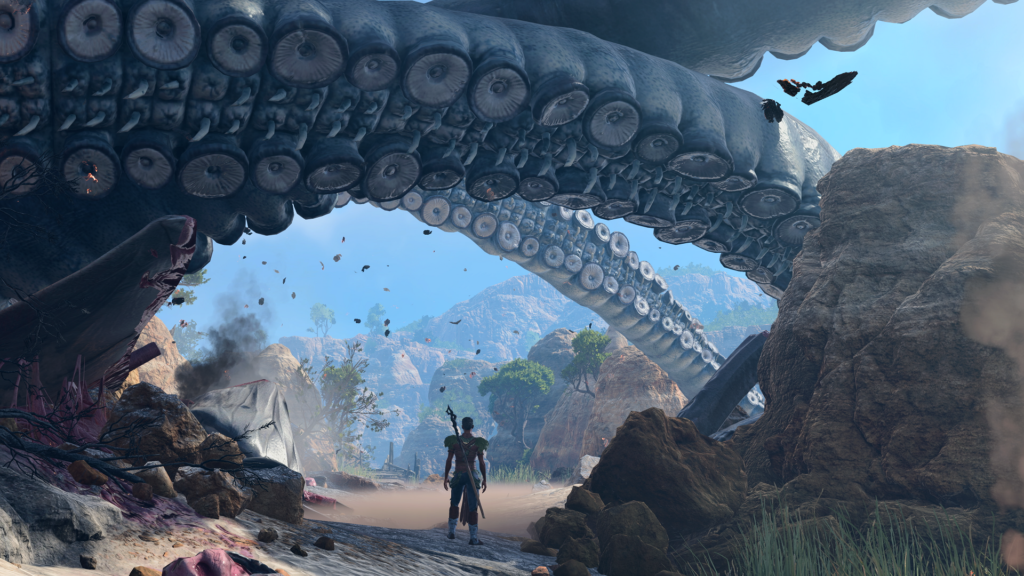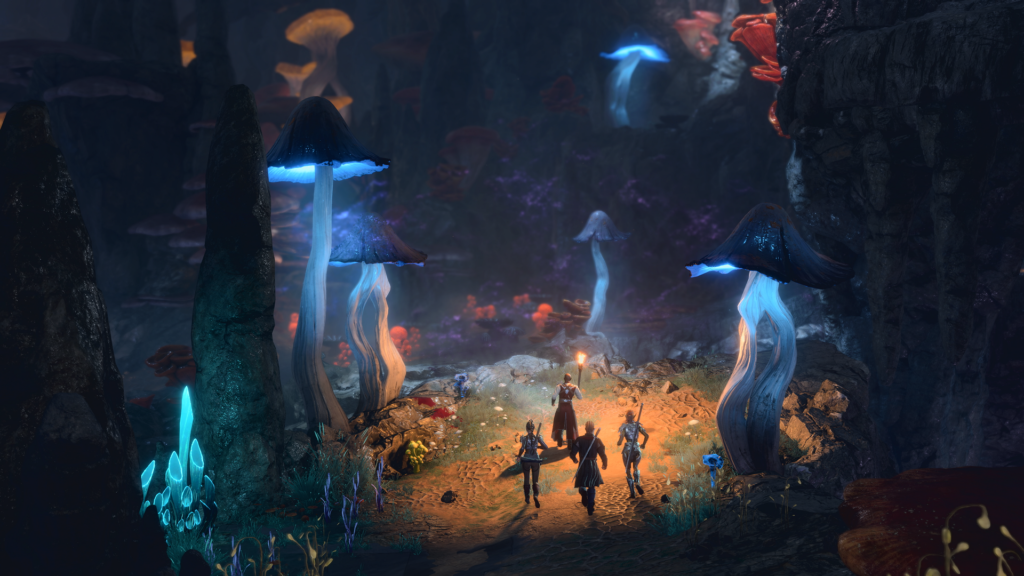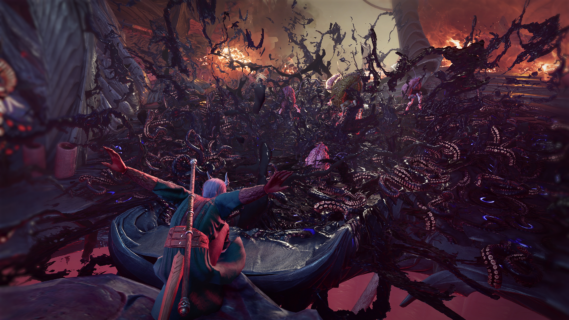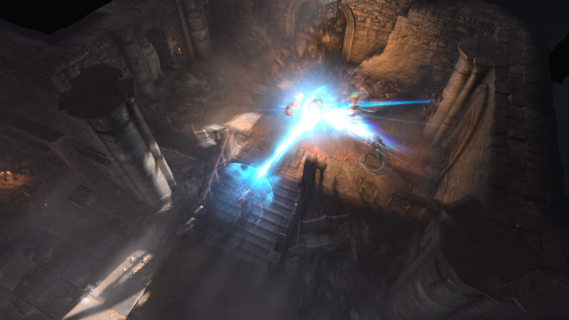I love CRPGs — Computer RPG, for those unfamiliar with the term. Some of my earliest gaming memories as a kid, aside from the Mario, Zelda, and Metroid games I had on my Nintendo consoles, centered around late nights playing games like Fallout, Planescape Torment, Elder Scrolls: Daggerfall, Wizardry 7, Ultima 7, and so many others at one of my friends’ houses. I didn’t really have a computer that would play these games until a couple years later so instead, I made due by digging into the library of Darren’s dads’ games with frequent overnight sleepovers and soda-fueled binges. Our favorite of the bunch and the one I remember playing most was Baldur’s Gate. The story of the dead god Bhaal, Lord of Murder, and its offspring to be known as Bhaalspawn, is seared into my brain despite not having played it in over 15 years. When my family bought a computer I could actually play games on, Baldur’s Gate 2 (and Diablo 2) were the first games I bought. I say this because for me personally, I approached Baldur’s Gate 3 with the sort of jaded skepticism that comes whenever a studio seeks to try and revitalize a franchise as celebrated as this particularly so many years later. Instead, Baldur’s Gate 3 not only meets expectations, but actually wildly surpasses them. In a year completely stacked with games worthy of topping lists in many others, Larian has managed to come through with what might end up sitting atop them all.

Larian was the perfect match
For many, the fact that Baldur’s Gate 3 is a good game won’t come as a surprise however. Larian Studios have been around for a long time creating RPGs in their Divinity Franchise. But it wasn’t really until Divinity: Original Sin that their popularity started to explode. Right away, the series became known for its whimsical writing, dense turn-based tactical battles with lots of elemental and environmental reactions, and especially with its sequel, Divinity: Original Sin 2, its solid quest and encounter design allowing many potential solutions to a problem or routes through the game. In this manner, these games took on an almost immersive sim level of freedom to explore and be creative that would typically be attributed to games like Deus Ex, Dishonored, and Prey.
The game was released in Early Access over 3 years ago and you can tell over the course of that time, they’ve only deepened their design philosophy here. It’s this commitment to being willing to say “yes” to the player that makes what Larian does such a great fit for the Dungeons & Dragons license. Even without a lot of experience in playing the tabletop game myself, it’s hard to shake the feeling that you aren’t just playing a game moderated by a Dungeon Master with chops reacting to your wild ideas. Running around the game world, you’ll constantly see dice rolling in the corner of your screen. Perception check for that treasure you can spot. History check to describe the old statue you walked by. Arcana check to read from a magical tome you found. Athletics to see whether you slip and fall on some grease you haphazardly walked through. The game will frequently have you roll dice yourself when you do speech or sleight of hand checks, stacking up the modifiers to reveal a satisfying or success when you pass. To the credit of the writers, Baldur’s Gate 3 makes both success and failure interesting. Sometimes, failure means you get into combat when you would’ve otherwise avoided it. Often, failure can lead to some very memorable outcomes or paths through the game you may not have otherwise taken. The reactivity of choices, consequences, and yes, luck contribute I think to the overall vibes of the D&D experience and is something that really shows through here.
The journey begins
I spent most of the time in my single player campaign playing as Wyll, the Warlock. Baldur’s Gate 3 comes with the ability to either select one of several Origin characters in the game, or to create your own custom character entirely. You can create your own character from the dozen or so classes from D&D 5e, but one benefit of an Origin character is you get a fully fleshed out backstory and questline to play through as you progress the campaign. It’s a nice way to get started quickly if you don’t want to role play your own character, but I can say I’m already looking forward to creating my own from scratch on my 2nd playthrough now that I am more familiar with the options I have at my disposal. From there, I was immediately thrust into the initial story sequence involving my character and others trapped on a Mind Flayer ship after having a tadpole inserted into my brain.
You’re told that in a matter of days, that tadpole will be the very thing that turns you into a Mind Flayer to join the army amassing to take over the world. After a sequence that crash lands you on the beach of Faerûn, it’s up to you to gather allies in a quest to figure out what is going on, who is behind this, and most immediately, how to get this tadpole out of your skull and prevent yourself from turning. The hook here is immediately engaging and it’s not long before you have a half dozen leads for how to solve your immediate problem — leads that will take you to all corners of the immense Act 1 maps. Throughout the game and especially in these early hours I found several potential companion characters, most of which turned out to be trapped on the Mind Flayer ship with me before the crash.
To Larian’s credit, the cast of recruitable companion characters are among the very best I’ve played in RPG and they endear themselves to you quickly. I mostly rolled with Karlach, Shadowheart, and Astarion the entire game and grew to love each one at different points in the story with Karlach being the immediate early highlight as the Tiefling Barbarian who has escaped hell with her heart replaced by an infernal engine and is attempting to redeem herself for the ages she spent doing the bidding of the evil Zariel, archdemon of Avernus. More than the great backstory, Karlach is just a remarkable hang and full of good vibes. I grew so attached to her as a character that there were several moments in her story that caused me to choke up a bit. The same can be said of each of the others as well. Shadowheart, the Cleric, worships a god of darkness and you can choose to lean into that or try to make her see the error of her ways. Astarion is a vampire thrall who has escaped the master who wants him back for nefarious purposes. The writing on display is truly what elevates things above the standard RPG fare and the incredible amount of amazing motion capture and voice acting just take it that much further. It’s hard to overstate how much effort has gone into the presentation here, with Larian claiming the game has over 170 hours of recorded and fully voiced dialogue cutscenes. Many great CRPGs have been released in recent years as the genre has started to become revitalized with games like Pathfinder: Wrath of the Righteous, Divinity Original Sin 2, Disco Elysium, and the Pillars of Eternity series, but it’s been probably since 2009’s Dragon Age: Origins that we’ve seen an attempt to marry deep party-based tactical combat with this level of presentation quality. It is one of the many things that sets the game apart and probably the distinguishing factor that has made it break through in popularity.

First class exploration and quest design
The story itself plays out over 3 Acts and each probably averaged me about 40 hours with Act 2 being the shortest. Act 1 mostly plays out in a rural countryside centered around a conflict between a grove of Druids and the threat of a nearby Goblin encampment. The Druids are currently housing Tiefling refugees and the unease that comes with this along with the increasing number of attacks has started to build up tensions to a potential powder keg situation. Aside from the central conflict, you’re given free reign to participate in any sides of the conflict, attempt to follow the threads of losing the tadpole in your brain, or just explore – and explore is what you’ll want to do. Never have I played an RPG with a map as dense as Baldur’s Gate 3. Every time my party walked to an area for the first time, I felt like I was being greeted by some new and interesting scenario the game’s Dungeon Master had cooked up for me. Almost every time I thought I was encountering some small side room, I found a hatch, locked door, or small opening and discovered that it went deeper and deeper, revealing parts of the area I never knew existed. What I thought would be a quick excursion turned often into a multi-hour affair. It’s hard to overstate how much there is in this game and how everything feels hand-crafted and worth doing. At a minimum, you’ll be rewarded with experience and a bit of lore. More often you’ll receive an entirely unique item that can only be obtained through that questline — an item that can potentially unlock a whole new way of playing one of the characters in your party.
The number of solutions to problems you encounter throughout the game can lead to some truly memorable moments. In one early scenario, I came across a burning building with somebody trapped on the inside. Attempting to explore my way inside and find a way to save them was harrowing, with explosions going off as the house started coming down around me. Fearing I was at an impasse, I backed out and found debris on the other side of the building I could attack to find an alternate route inside the first floor. However, because the stairs had collapsed and I had no way of getting to the top floor, I ended up stacking nearby crates into a ladder that allowed my party to climb their way up, unlocking a hallway door that led me to the person who needed saving and escorting them out. I’m certain this is just one of several ways I could’ve done this but it nonetheless made me feel like I found a novel solution that worked for the set of skills I had at my disposal. This feeling and these moments of discovery happen throughout the entirety of the game even as the scope narrows a bit into the more spooky and focused Act 2 before the game blows wide open again in its final Act 3, set within the city of Baldur’s Gate itself.

The ultimate combat sandbox
Baldur’s gate 3 is a tactical, turn-based RPG still and frequently the exploration you do will result in combat encounters. Here’s another area where Larian has really polished their formula since Divinity Original Sin 2. They’ve really done an exceptional job of making turn-based combat feel a lot more snappy. After rolling initiative to determine turn order, characters are allowed to move, take an action, and take a bonus action, in really any order they want. Actions typically involve attacks, dashing for extra movement, or casting a spell. Bonus actions usually involve some minor spells, drinking potions, or using one of the many in-combat verbs such as Throw, Push, Dip, or Hide. One of the nice things I appreciated here is that if you have more than one character taking their turns back-to-back, you can swap between them freely to take all or parts of their turns in any order you choose, adding a nice layer of tactical consideration. Enemies will often do the same thing, the advantage here being that their turns can be a lot faster than usual turn-based games, particularly when you have swarms of minor enemies in a fight all taking simultaneous turns.
Despite these immediate improvements and all the general options at my disposal, I felt the game’s combat started a little on the slow side. Characters in D&D 5e really don’t start out feeling all that powerful and missed attacks are a lot more frequent than I was expecting, turning some combat encounters into a bit of a war of attrition. It really doesn’t take long to hit that turning point though, which for most characters comes around level 4 or 5. By this point, you have access to some pretty powerful spells, your martial characters have obtained their extra attack per turn, and you’ve likely been able to level your primary stats to the point where you are hitting your attacks the majority of the time. My party turned into one where Wyll, my Warlock, was capable of flinging anyone I wanted off the map with powerful Eldritch Blasts, a Hastened and Blessed Karlach would rampage through swaths of enemies, attacking between 4 and 6 times per turn with 98% accuracy, and Astarion would crit backstab or mind control nearly any enemy to fight for me. Then if all else failed, scenario encounters usually still provided me with ways of dealing with any limitations my party had. One particular scenario involved a room full of spiders that would phase around the room onto webbing my party couldn’t easily reach. I had to redo this fight once or twice before realizing that my party’s fire spells would incinerate the webbing they were on. This caused them to either fall into a chasm to their death or take massive damage from the fall to the surface below.

Fun with friends
This last example was actually the result of some group strategic thinking in my 4-player multiplayer campaign. Yes, this game allows you to experience the entirety of the campaign in full cooperative play, turning a great single player RPG filled with choice and consequences into what truly begins to feel like playing a D&D campaign with your friends. There’s something magical about all being able to roll your own characters and get into the kind of hijinks that only having four players wandering around simultaneously can provide. While that chaos can be entertaining, we learned pretty quickly that staying together and experiencing dialogue cutscenes and story moments together was the way to go, lest we accidentally spark a civil war that ended up in mass murder because of the action of one player across the screen.
Played under these terms though, cooperative multiplayer is insane fun and made even better by some of the combat improvements mentioned above where players who share spots in the turn around can take their actions simultaneously, lending a flow to combat that feels like very little downtime — an important element when you go from controlling four characters to just one. While you do lose some of the magic of having such compellingly written side characters in your party, what you mostly lose out is flavor since the characters end up hanging back at your camp waiting for you to discuss how to proceed with each of their side stories. Ultimately, in what is already a staggeringly impressive package, the fact that Larian has gone to the amount of effort they have to continue to include cooperative multiplayer in their games is a testament to their commitment to recreating the tabletop experience digitally. There isn’t an RPG of this quality and scale that can offer something similar.

A game that is still improving
While my over 120 hours with the game was almost entirely a magical experience spent in awe of just how much I could push up against the freedom the game afforded me and have it remember and react accordingly, Act 3 is when the cracks started to show a little. While this had next to no impact on my own enjoyment of the game, it’s tough to say that the final 40 or so hours of the game is as seamless as what came before. While I never got anything that was as bad as being soft-locked out of quest completions, I would frequently discover elements of quests out of order before actually talking to the quest-giver, which would result in some awkward dialogue choices and character interactions that made it seem like I hadn’t already taken care of what they were asking of me. Most games honestly don’t handle this type of thing that great either, but when the first two acts seemingly accounted for every possible scenario and sequence break I did, moments like these in Act 3 stood out. Performance ends up dipping in Act 3 more than I would’ve liked as well, with most outdoor areas dipping around 15 fps lower than I was experiencing in Act 1 and 2 likely because of the density of buildings and NPCs sprinkled throughout the city.
This was all something I felt was easily forgivable however just because of the scale of what they’ve built. Act 3, set in the city of Baldur’s Gate, is easily the most densely packed urban area there has ever been in an RPG. Literally every building you can walk into and will want to. After the tight and streamlined Act 2 and all the reveals that occurred at the end of it, I was pretty down on Act 3 to start because of just how expansive it is immediately and tells the player to go wander again. This feeling went away within hours and I immediately was wrapped up in the conclusions of several of my party members’ stories — Astarion’s in particular being a highlight for me. Baldur’s Gate is where so many of the threads that the game has been juggling since Act 1 come to satisfying conclusions in so many surprising ways. With some additions and polish from Larian, it’s only going to continue to get more impressive in the months ahead.
Luckily, support from Larian has already been quick and extensive. As of this writing, Patch 1 has been released and with it a list of over 1,000 bug fixes, most of which to Act 3 having to do with scripting and sequence breaks issues. They’ve also started to talk about the upcoming Patch 2, which is going to have material changes to the game based on player feedback. Their track record of improving their previous games and then packaging them into a free Definitive Edition update is well established and from the looks of it so far, Baldur’s Gate 3 will be no exception.
I played Baldur’s Gate 3 on a PC with the following specs:
– Microsoft Windows 11 Pro
– Intel Core™ i7-13700KF 16-Core 3.4 GHz
– EVGA NVIDIA GeForce RTX 3080 Ti
– Team T-Force Delta RGB 32GB DDR4 3200 MHz
– LG UltraGear 34GP950B-G (21:9 Ultrawide @ 3440×1440)

A towering achievement
None of this even remotely takes away from the fact that anyone interested in Baldur’s Gate 3 should buy this and buy this now. To take nothing away from the excellent RPGs that have come out recently, I have waited over a decade for this type of crunchy, immaculately written, tactical fantasy RPG to be combined with the type of AAA presentation that Larian has achieved here. It’s a landmark title in the genre in the same way that Baldur’s Gate 1 and 2 were decades ago and will be remembered for years to come as the masterpiece that it is.
A Steam code was provided in advance by the publisher for review purposes




